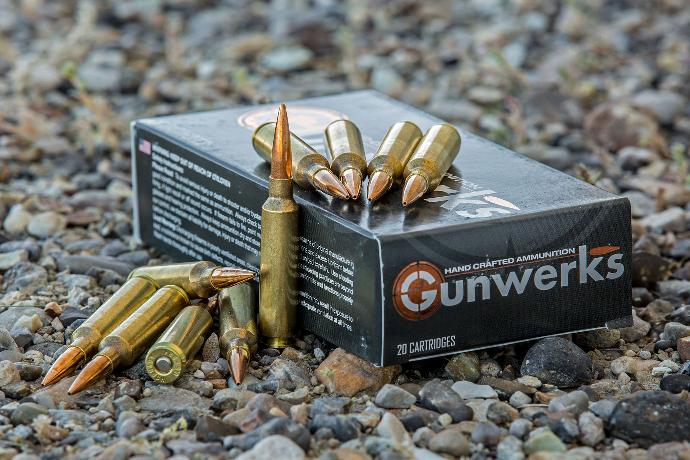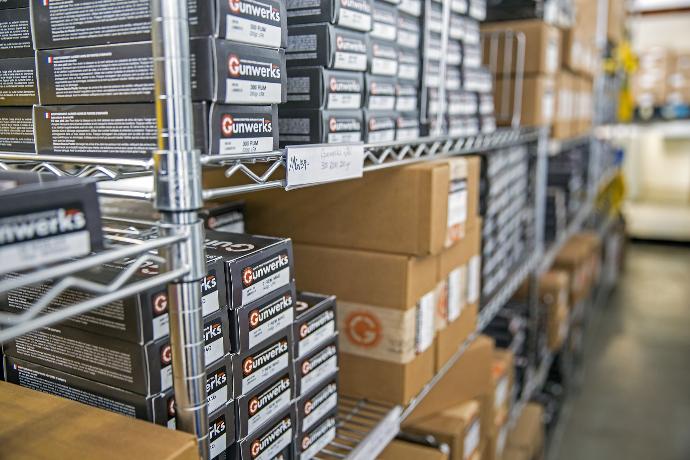
Books, countless articles, video series, and even classes have been devoted to the subject of long range shooting and the quality o ammunition needed to achieve success. Many shooters can’t agree on what distance constitutes long range, much less the specific steps or equipment needed for that first-shot hit or to hold a tight group. Specific to ammunition, disregarding shooter ability or rifle accuracy, we can easily consider 500-600 yards and further as long range. That distance is where we really start to see variations in components or loading techniques affect the bullet’s point of impact or group size. Loads that may be acceptable at 300-yards may not have the consistency required for a 600-yard shot. Small inconsistencies in ammo due to velocity variation or mixed cases don’t affect most recreational and competitive shooters at close range. For example, assume you are shooting a 223 Rem with a 75-grain BTHP loaded to 2,700 fps and your velocity extreme spread is 50 fps. At 200 yards, assuming your rifle is shooting perfectly, you will have a vertical string of .30-inches. Very few rifle and shooter combinations are good enough to notice a .30-inch variation at 200 yards. When you stretch the range out to 600 yards, that same 50 fps velocity variation is now 4.8-inches. That, coupled with the accuracy limitations of the rifle, can result in a miss on small targets. At 1,000 yards, the vertical string nears 20-inches. Obviously, velocity extreme spread (ES) is something we want to keep to a minimum.
Here are some considerations in minimizing ES and other ways to maximize the consistency and accuracy in ammunition for long range shooting.
Projectiles
The bullet itself is the foundation for accurate ammunition. Finding the best bullet for your particular firearm and barrel requires some trial and error. It is important to test these projectiles at longer ranges rather than relying on 100 or 200-yard accuracy.
For long range consistency, sort and remove bullets based on weight and length variations. Larger bullets (30-caliber and above) can withstand slightly more weight variation than smaller bullets. Bullet length is important as well for consistency. The best measurement is from the base to give location using a bullet comparator and keep variation less than .005-inches.
Bullets used for long range shooting feature low drag profiles that include a long ogive and boat tail base. The measurement of how slippery a bullet is in the air is known as the bullet’s ballistic coefficient or BC. The higher the BC, the less effect drag has on the bullet. There are practical and manufacturing limits on how long a bullet can be. Keep in mind that the longer and more aggressive the profile, the faster the twist rate in your barrel has to be to stabilize the bullet and shoot accurately.
When the bullet will be used for hunting vs traditional target shooting you have to consider the terminal performance of the bullet when it impacts the animal at the retained velocity it will have at the maximum range you intend to shoot. In addition to shooting well in your rifle the bullet should:
Have a high ballistic coefficient (BC). A bullet with a high BC will retain its velocity to a further range and therefore expand as designed to a greater distance than a bullet with a low BC. A bullet with a high BC will also resist the effects of wind better and be more forgiving of a poor wind call.
Have a terminal performance that matches the intended game and gives sufficient penetration to reach the vitals while doing the maximum amount of damage possible. All bullets are a compromise, and a bullet which performs well in the lungs with an 1800 fps impact velocity at 800 yards may fail to penetrate with a 2500 fps impact velocity in the shoulder at 100 yards. A bullet which is tough enough to survive the 2500 fps impact in the shoulder and penetrate, may not expand and pencil through on the 1800 fps impact.
It is important to know the strengths and weaknesses of your chosen bullet and make your shot placement accordingly.
Powders & Primers
Propellants, much like bullets, require some testing for finding the best results. Where shorter distances (300-yards and in) are minimally affected by .3 grains in variation, long range shooting requires the variation to be as low as possible. Using an accurate, calibrated electronic scale to weigh each charge is beneficial to keep your velocities consistent.
Consistency requires the least amount of temperature sensitivity. Single base propellants (nitrocellulose) have significantly less performance variation with temperature fluctuation than double base (nitrocellulose plus nitroglycerin) powders. This is important if you expect to shoot in different climates. Examples of single base powders include the IMR Enduron, Hodgdon Extreme, and Vihtavuori 100 series.
Keep in mind that accuracy is more important than speed at long range. Don’t give up consistency to gain an extra 40 fps. Propellants with faster burn rates for the cartridge you are loading tend to produce better accuracy.
Like projectiles and propellants, experiment with different primers. Avoid using magnum primers unless you are shooting a magnum. Magnum primers provide a more violent ignition, which in non-magnum cases increases inconsistency.
Chronographs
Chronographs provide information which is critical for the long range hunter. It provides you with an average velocity, essential for predicting the trajectory of the bullet down range.
Velocity variation or Extreme Spread - The lower you can get the ES of your ammunition the less vertical dispersion you will have at long range. Animal vitals are roughly rectangular shaped and more forgiving of a windage error than a vertical error. This makes a low ES even more important and with good attention to detail and good components an ES of under 20 fps is desirable and attainable.
Old style chronographs which utilize skyscreens and are dependent on “seeing” the shadow of the bullet as it passes are finicky and not nearly as precise as modern designs. There are two basic types of modern chronographs.
A Magneto Speed attaches to the muzzle of the rifle and as the name suggests uses a magnet to track the speed of the bullet as it leaves the muzzle. These are very reliable, even on public ranges where there are other shooters. The downside, is because you are attaching mass to the muzzle you can not confirm zero or test accuracy at the same time you are capturing velocity and testing extreme spreads. Because of this you will shoot a significant number more rounds to find a load which has good accuracy and minimal extreme spreads.
Radar units - These include the LAB Radar and the Garmin Xero. Both work by utilizing radar to track the bullet as it goes down range. The LAB Radar, and likely the Garmin, are great pieces of gear because they allow you to track velocities and extreme spreads at the same time as you test accuracy or confirm zero.
Cartridge Cases
Cartridge cases are also critical as they bring all of the components together. Weight and capacity vary, not only from one manufacturer to another, but within a lot of cases. Sorting cases adds to consistency. Separating cases by the number of times they’ve been fired is also recommended as cases work harden.
For long range consistency, sort cases in 1-grain weight increments. Deburr flash holes and ensure that primer pocket depths are uniform. This helps provide a more even primer ignition and flash.
Neck thickness is also very important for consistency. When the propellant ignites and the case expands to fill the chamber, a neck thickness issue would force one part of the neck to touch the chamber before the rest of the neck, promoting inconsistency. Using a neck thickness tool or ball micrometer can help you weed out any affected cases.
Some shooters find success in building tight chambers and turning (removing brass from) the necks of their cartridge cases down to fit.
Within the last few years the premium brass has improved to the point that sorting cases by weight, turning necks, uniforming primer pockets and deburring flash holes, while potentially beneficial, is not nearly as important as it was even 10 years ago. Gunwerks brass is held to a very high standard.
Reloading Die Sets
When hand loading or reloading, there are specific steps and equipment that can help maximize consistency and accuracy.
When a cartridge is fired, it expands to the walls of the chamber. When reloading that cartridge case, you have the option of resizing the whole case back to its original size, or simply sizing the neck down and leaving the body the size of your chamber. Consistency can be gained with leaving the case body the size of the rifle it was fired in. Much like case neck consistency, if the case body expands and touches one side of the chamber first, rather than contacting all sides evenly, it can lead to inconsistency. Leaving the body the size of the chamber minimizes this. Of course there are limitations to neck sizing. You only want to use neck-sized ammunition in the gun it was originally fired in. Also, it is not recommended in semi-autos as it can lead to feeding issues. Neck sizing without pushing the case shoulder back can make it difficult to close the bolt. The best scenario is to properly setup a full-length sizing die to bump the shoulder back minimally for correct headspace as you size the neck.
Using die sets that feature a floating style seating stem can help ensure that the bullet is seated straight in the cartridge case. When a bullet is not seated straight, you can visually see a wobble in the bullet when rolling the cartridge on a hard surface. The wobble, or run-out, can affect the accuracy of the load. Run-out should be kept below .004-inches for long range shooting. It is also helpful to use seating stems that match the profile of the bullet you are using.
Cartridge Overall Length (C.O.A.L.)
When seating bullets, experiment with various jumps to the lands (where the rifling starts in your barrel) to establish the best accuracy load. Using effective tools can help in this process immensely. Typically, a short jump of .000-.003-inches provides the best accuracy. Some rifles will shoot very well if the bullet is “jammed” a few thousands into the rifling. The danger is if you remove the round from the chamber without firing, you run the risk of the bullet getting stuck in the throat rendering the rifle worthless until you find a cleaning rod to remove it. A longer jump of as much as .020 inches provides more leeway to prevent this from happening even as carbon fouling builds up inside the throat. Once again life is a compromise and for most, reliability in the field is more important than a quarter minute of angle in group size.
Remember that measuring to the ogive is a more consistent measurement than measuring to the bullet tip.
Factory Ammunition
Improving on factory ammunition by hand loading is not as easy as it once was. Factory match loads can provide extremely good consistency. Some factory loads can also reach velocities using proprietary powder blends that hand loaders cannot achieve with off-the-shelf propellants within established pressure limits.
Shooters who either lack the time for hand loading, or don’t wish to invest in the equipment have viable alternatives with factory match ammunition in a number of popular calibers. Stick with manufacturers that have a reputation for precision.
Factory ammunition often has some velocity variations from lot number to lot number. If you choose to shoot factory ammunition, buy as much of the same lot number at once as possible, then chronograph it to get an accurate average velocity to build an accurate ballistic profile. If you switch lot numbers check the velocity again and modify your ballistic profile accordingly.

Ammunition For Long Range Shooting